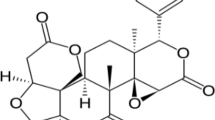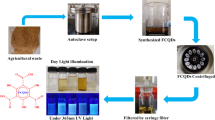Abstract
A ratiometric fluorescence platform was developed based on the cobalt oxyhydroxide (CoOOH) nanosheet–modulated fluorescence response of blue emissive copper nanoclusters (Cu NCs) and yellow emissive o-phenylenediamine (OPD). CoOOH nanosheets showed dual function of strong absorption and oxidation ability, which can effectively quench the blue fluorescence of Cu NCs, with an excitation and emission peak maximum at 390 and 450 nm, respectively , and transfer the OPD into yellow fluorescence products, with an excitation and emission peak maximum at 390 and 560 nm, respectively. Upon introducing butyrylcholinesterase (BChE) and its substrates, CoOOH nanosheets were decomposed into Co2+, and malachite green (MG) showed strong inhibition ability to this process. This resulted in the obvious difference on the ratio of blue and yellow fluorescence recorded on the system in the presence and absence of MG, which was utilized for the quantitative detection of MG, with a limit of detection of 0.140 μM and a coefficient of variation of 3.5%. The fluorescence ratiometric assay showed excellent detection performances in practical sample analysis.
Graphical abstract






Similar content being viewed by others
References
Srivastava SJ, Sinha RJ, Roy D (2004) Toxicological effects of malachite green. Aquat Toxicol 66(3):319–329. https://doi.org/10.1016/j.aquatox.2003.09.008
Qiu JY, Na LH, Li YM, Bai WF, Zhang JP, Jin L (2022) N, S-GQDs mixed with CdTe quantum dots for ratiometric fluorescence visual detection and quantitative analysis of malachite green in fish. Food Chem 390:133156. https://doi.org/10.1016/j.foodchem.2022.133156
Teepoo SW, Wongtongdee U, Phapugrangkul P (2020) Development of qualitative and quantitative immunochromatographic strip test assay for rapid and simple detection of leucomalachite green residual in aquatic animals. Food Chem 320:126613. https://doi.org/10.1016/j.foodchem.2020.126613
Dong JX, Li ZF, Wang Y, Jin MJ, Shen YD, Xu ZL, Abd El-Aty AM, Gee SJ, Hammock BD, Sun YM, Wang H (2021) Generation of functional single-chain fragment variable from hybridoma and development of chemiluminescence enzyme immunoassay for determination of total malachite green in tilapia fish. Food Chem 337:127780. https://doi.org/10.1016/j.foodchem.2020.127780
Wang Q, Hu RJ, Chen MM, Zhang JX, Chen LC, Lin ZY, Dong YQ, Fu FF (2021) Hybridizing carbon-based dot-capped manganese dioxide nanosheets and gold nanoparticles as a highly sensitive surface-enhanced Raman scattering substrate. Analytical Chem 93(28):9744–9751. https://doi.org/10.1021/acs.analchem.1c01181
Baesu A, Audet C, Bayen S (2022) Evaluation of different extractions for the metabolite identification of malachite green in brook trout and shrimp. Food Chem 369:130567. https://doi.org/10.1016/j.foodchem.2021.130567
Tian HH, Li HB, Fang Y (2019) Binary thiol-capped gold nanoparticle monolayer films for quantitative surface-enhanced Raman scattering analysis. ACS Appl Mater Interfaces 11(17):16207–16213. https://doi.org/10.1021/acsami.9b02069
Song J, Lai SY, Wang DN, Wu XM, Zhang YM, Pang LJ, Chai TT, Zhao J, Wang XD (2020) Simultaneous colorimetric sensing of malachite & leucomalachite green in aquatic products based on novel ionic associate self-visualization HPTLC strips. Sens Actuators B Chem 325:128753. https://doi.org/10.1016/j.snb.2020.128753
Yue XY, Fu L, Li Y, Xu S, Lin X, Bai YH (2023) Lanthanide bimetallic MOF-based fluorescent sensor for sensitive and visual detection of sulfamerazine and malachite. Food Chem 410:135390. https://doi.org/10.1016/j.foodchem.2023.135390
Chen X, Chen K, Du ZH, Chu HS, Zhu LJ, He XY, Xu WT (2022) Fusion of binary split allosteric aptasensor for the ultra-sensitive and super-rapid detection of malachite green. J Hazard Mater 425:127976. https://doi.org/10.1016/j.jhazmat.2021.127976
Fang W, Zhang B, Han FY, Qin ZN, Feng YQ, Hu JM, Shen A-G (2020) On-site and quantitative detection of trace methamphetamine in urine/serum samples with a surface-enhanced raman scattering-active microcavity and rapid pretreatment device. Anal Chem 92(19):13539–13549. https://doi.org/10.1021/acs.analchem.0c03041
Scott AT, Layne TR, O’Connell KC, Tanner NA, Landers JP (2020) Comparative evaluation and quantitative analysis of loop-mediated isothermal amplification indicators. Anal Chem 92(19):13343–13353. https://doi.org/10.1021/acs.analchem.0c02666
Concellón A, Castro-Esteban J, Swager TM (2023) Ultratrace PFAS detection using amplifying fluorescent polymers. J Am Chem Soc 145(20):11420–11430. https://doi.org/10.1021/jacs.3c03125
Ahmed N, Zareen W, Ye Y (2022) Recent development in fluorescent probes based on attacking of double bond and masking of functional group. Chin Chem Lett 33(6):2765–2772. https://doi.org/10.1016/j.cclet.2021.12.092
Uchinomiya S, Nagaura T, Weber M, Matsuo Y, Zenmyo N, Yoshida Y, Tsuruta A, Koyanagi S, Ohdo S, Matsunaga N, Ojida A (2023) Fluorescence-based detection of fatty acid β-oxidation in cells and tissues using quinone methide-releasing probes. J Am Chem Soc 145(14):8248–8260. https://doi.org/10.1021/jacs.3c02043
Zhou XM, Huang SJ, Zhang D, Liu WF, Gao WX, Xue YM, Shang L (2023) Gold nanocluster-based fluorescent microneedle platform toward visual detection of ATP. Anal Chem 95(32):12104–12112. https://doi.org/10.1021/acs.analchem.3c02242
Hu YP, Gao ZJ, Luo JF (2021) Fluorescence detection of malachite green in fish tissue using red emissive Se,N,Cl-doped carbon dFots. Food Chem 335:127677. https://doi.org/10.1016/j.foodchem.2020.127677
Wu L, Lin ZZ, Zhong HP, Chen XM, Huang ZY (2017) Rapid determination of malachite green in water and fish using a fluorescent probe based on CdTe quantum dots coated with molecularly imprinted polymer. Sens Actuators B Chem 239:69–75. https://doi.org/10.1016/j.snb.2016.07.166
Park SH, Kwon N, Lee JH, Yoon J, Shin I (2020) Synthetic ratiometric fluorescent probes for detection of ions. Chem Soc Rev 49(1):143–179. https://doi.org/10.1039/c9cs00243j
Wu L, Wu IC, DuFort CC, Carlson MA, Wu X, Chen L, Kuo CT, Qin Y, Yu J, Hingorani S R, Chiu DT (2017) Photostable ratiometric Pdot probe for in vitro and in vivo imaging of hypochlorous acid. J Am Chem Soc 139(20):6911–6918. https://doi.org/10.1021/jacs.7b01545
Gui WY, Wang H, Liu Y, Ma Q (2018) Ratiometric fluorescent sensor with molecularly imprinted mesoporous microspheres for malachite green detection. Sens Actuators B Chem 266:685–691. https://doi.org/10.1016/j.snb.2018.03.176
Yue XY, Li Y, Xu S, Li JG, Li M, Jiang LY, Jie MS, Bai YH (2022) A portable smartphone-assisted ratiometric fluorescence sensor for intelligent and visual detection of malachite green. Food Chem 371:131164. https://doi.org/10.1016/j.foodchem.2021.131164
Ju YJ, Li N, Liu SG, Han L, Xiao N, Luo HQ, Li NB (2018) Ratiometric fluorescence method for malachite green detection based on dual-emission BSA-protected gold nanoclusters. Sens Actuators B Chem 275:244–250. https://doi.org/10.1016/j.snb.2018.08.052
Shi YE, Ma JZ, Feng AR, Wang ZG and Rogach AL (2021) Aggregation‐induced emission of copper nanoclusters. Aggregate 2(6):e112. https://doi.org/10.1002/agt2.112
Lai WF, Wong WT, Rogach AL (2020) Development of copper nanoclusters for in vitro and in vivo theranostic applications. Adv Mater 32(9):e1906872. https://doi.org/10.1002/adma.201906872
Li GL, Kong WH, Zhao M, Lu SM, Gong PW, Chen G, Xia L, Wang H, You JM, Wu YN (2016) A fluorescence resonance energy transfer (FRET) based “Turn-On” nanofluorescence sensor using a nitrogen-doped carbon dot-hexagonal cobalt oxyhydroxide nanosheet architecture and application to α-glucosidase inhibitor screening. Biosens Bioelectron 79:728–735. https://doi.org/10.1016/j.bios.2015.12.094
Zhang Y, Lu ZD, Feng AR, Lam JWY, Wang ZG, Shi YE, Tang BZ (2023) Green‐emissive copper nanocluster with aggregation‐enhanced emission for selective detection of Al3+. Chem Eur J 29(13). https://doi.org/10.1002/chem.202203554
Wang Y, Tu AP, Zhang XW, Li MY, Liu LC, Li YF, Wu JL, Zhang P (2021) Defect-rich CoOOH nanorings: A biocompatible and cost-efficient material for clinical diagnosis of children heart failure. Chem Eng J 426:131834. https://doi.org/10.1016/j.cej.2021.131834
Wen SH, Zhong XL, Wu YD, Liang RP, Zhang L, Qiu JD (2019) Colorimetric assay conversion to highly sensitive electrochemical assay for bimodal detection of arsenate based on cobalt oxyhydroxide nanozyme via arsenate absorption. Anal Chem 91(10):6487–6497. https://doi.org/10.1021/acs.analchem.8b05121
Luo L, Lin SQ, Wu ZY, Wang H, Chen ZJ, Deng H, Shen YD, Zhang WF, Lei HT, Xu ZL (2022) Nanobody-based fluorescent immunoassay using carbon dots anchored cobalt oxyhydroxide composite for the sensitive detection of fenitrothion. J Hazard Mater 439:129701. https://doi.org/10.1016/j.jhazmat.2022.129701
Lin B, Wang AY, Guo YL, Ding YQ, Zhan WC, Wang L, Guo Y, Gao F (2020) Elimination of NO pollutant in semi-enclosed spaces over sodium-promoted cobalt oxyhydroxide (CoOOH) by oxidation and adsorption mechanism. Appl Catal B 279:119404. https://doi.org/10.1016/j.apcatb.2020.119404
Li YL, Feng LY, Yan W, Hussain I, Su L, Tan B (2019) PVP-templated highly luminescent copper nanoclusters for sensing trinitrophenol and living cell imaging. Nanoscale 11(3):1286–1294. https://doi.org/10.1039/c8nr07142j
Dai ZH, Wang GF, Xiao FF, Lei D, Dou XC (2023) Amorphous copper‐based nanoparticles with clusterization‐triggered phosphorescence for ultrasensing 2,4,6‐trinitrotoluene. Adv Mater 35(24). https://doi.org/10.1002/adma.202300526
Wang ZG, Susha AS, Chen BK, Reckmeier C, Tomanec O, Zboril R, Zhong HZ, Rogach AL (2016) Poly(vinylpyrrolidone) supported copper nanoclusters: glutathione enhanced blue photoluminescence for application in phosphor converted light emitting devices. Nanoscale 8(13):7197–7202. https://doi.org/10.1039/c6nr00806b
Cheng H, Hui P, Peng JX, Li W, Ma WJ, Wang HZ, Huang J, He XX, Wang KM (2021) Enzymatic behavior regulation-based colorimetric and electrochemiluminescence sensing of phosphate using the cobalt oxyhydroxide nanosheet. Anal Chem 93(17):6770–6778. https://doi.org/10.1021/acs.analchem.1c00557
Funding
This work was financially supported by the National Natural Science Foundation of China (22175052), Science Fund for Creative Research Groups of Nature Science Foundation of Hebei Province (B2021201038), Central Government Guided Local Science and Technology Development Fund (Hebei, 236Z0602G), and Research Innovation Team of College of Chemistry and Environmental Science of Hebei University (hxkytd-py2101).
Author information
Authors and Affiliations
Corresponding authors
Ethics declarations
Conflict of interest
The authors declare no competing interests.
Additional information
Publisher's Note
Springer Nature remains neutral with regard to jurisdictional claims in published maps and institutional affiliations.
Supplementary Information
Below is the link to the electronic supplementary material.
Rights and permissions
Springer Nature or its licensor (e.g. a society or other partner) holds exclusive rights to this article under a publishing agreement with the author(s) or other rightsholder(s); author self-archiving of the accepted manuscript version of this article is solely governed by the terms of such publishing agreement and applicable law.
About this article
Cite this article
Zhang, Y., Shi, Ye., Wang, S. et al. Cobalt oxyhydroxide nanosheet–modulated ratiometric fluorescence platform for the selective detection of malachite green in fish. Microchim Acta 191, 119 (2024). https://doi.org/10.1007/s00604-024-06200-y
Received:
Accepted:
Published:
DOI: https://doi.org/10.1007/s00604-024-06200-y




